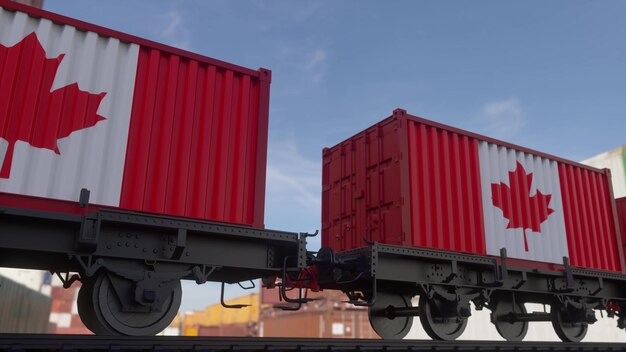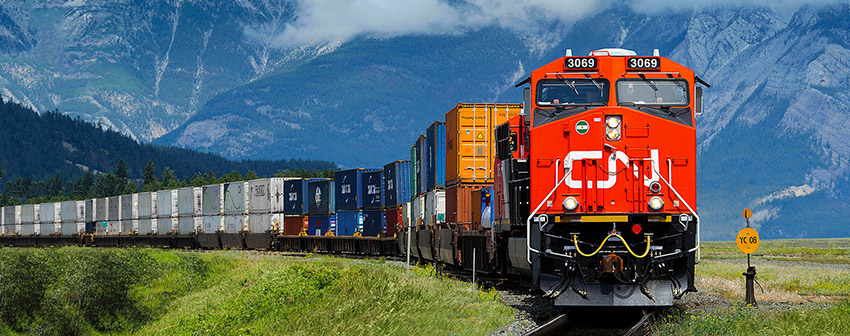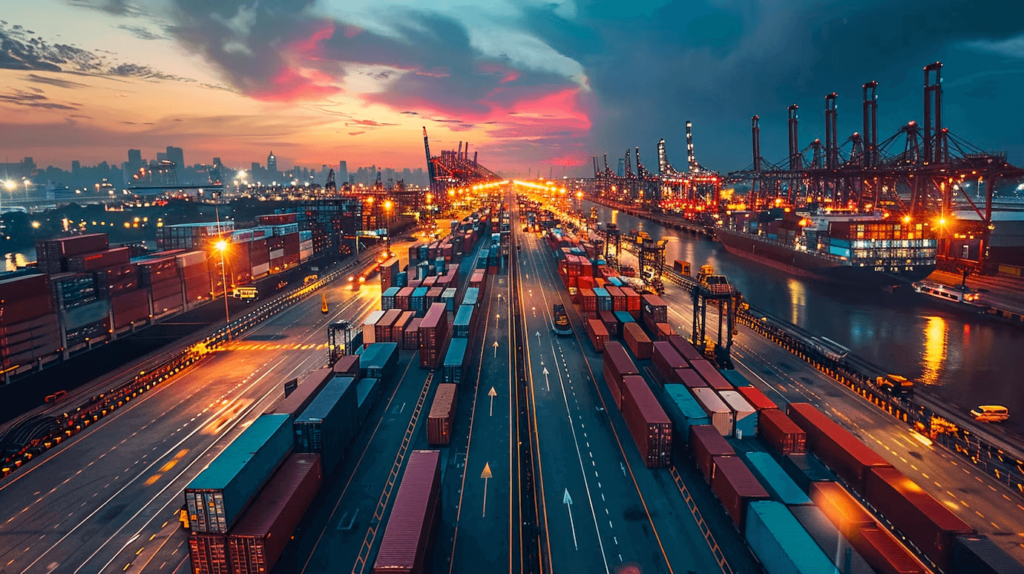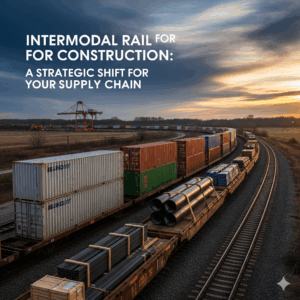Editor’s note: This post was initially published in December 2022 and has since been revised for comprehensiveness
Intermodal Terminals in Canada: The Backbone of Smarter, Faster Freight Movement
Canada, a global leader in resource exports and advanced manufacturing, relies heavily on its vast network of intermodal terminals to keep goods flowing efficiently across borders and continents. From Vancouver to Halifax, intermodal terminals in Canada are the unsung heroes of international trade—connecting rail, truck, and ocean freight in one seamless system. These logistics hubs play a critical role in supply chain management, helping businesses reduce costs, improve delivery times, and boost overall freight visibility.
Over the past two decades, Canada’s intermodal infrastructure has expanded dramatically, responding to surging global eCommerce, manufacturing shifts, and rising demand for sustainable transportation solutions. The increasing use of intermodal shipping—the strategic movement of goods using multiple modes without handling the freight itself—has made intermodal terminals in Canada more vital than ever before.
Whether you’re a logistics manager shipping bulk commodities from Alberta, high-tech electronics from Ontario, or refrigerated goods across borders, knowing where and how Canada’s intermodal terminals operate gives you a clear competitive edge. These facilities serve as major connectors between ports, inland distribution centers, and major U.S. freight corridors—fueling everything from cross-border trade to domestic eCommerce fulfillment.
So, which intermodal terminals in Canada are driving the country’s freight future? Keep reading as we break down the top ten intermodal terminals transforming Canadian logistics in 2024—complete with capacity stats, key routes, and value to your supply chain.

What Is Intermodal?
Intermodal transportation is the backbone of modern freight logistics, offering an efficient, scalable, and sustainable way to move goods across vast distances using a combination of transportation modes. At its core, intermodal shipping refers to the movement of cargo in a single container or standardized unit (such as a 20-ft or 53-ft intermodal container) that is transferred between modes—such as ships, trains, and trucks—without handling the actual contents during mode changes.
This mode of freight transportation has revolutionized how companies manage global and domestic supply chains. Instead of relying solely on trucks or ocean freight, shippers can now integrate rail for long-haul movement, trucks for last-mile delivery, and container ships for international legwork, all while keeping the cargo in a sealed, secure unit. This approach minimizes cargo handling, which significantly reduces the risk of damage, loss, theft, and delays—issues that are often prevalent in single-mode shipping.
But the benefits go well beyond cargo integrity. Intermodal transport is increasingly being adopted for its cost efficiency and environmental advantages. Rail, for example, is significantly more fuel-efficient than trucking over long distances—helping businesses lower fuel costs and carbon emissions. When integrated with optimized trucking legs at either end, intermodal freight becomes a flexible, cost-effective solution for both long-haul and regional freight moves.
In Canada, intermodal logistics is particularly crucial due to the country’s expansive geography, port infrastructure, and trade-heavy economy. Intermodal terminals in cities like Toronto, Vancouver, Montreal, Calgary, and Winnipeg act as critical gateways, connecting ocean freight with inland rail routes and distribution centers. These terminals facilitate seamless intermodal transfers, ensuring products move smoothly between provinces or across international borders.
Some common examples of intermodal shipping include:
- A container of electronics manufactured in Ontario is transported via rail from Toronto to Vancouver, then transferred onto an ocean vessel bound for Asia.
- Temperature-controlled cargo, like pharmaceuticals or perishable foods, moves from a Quebec-based cold storage warehouse by truck to a CN intermodal terminal, then by rail to the U.S. Midwest.
- A 53-ft dry container of machinery parts is loaded in Edmonton, transported by train to the U.S. border, and completed with a short truck leg to its final destination in Texas.
The key advantage of intermodal transportation lies in its optimization of resources. Rather than choosing between cost, speed, or sustainability, intermodal lets you balance all three—offering the agility of trucking, the efficiency of rail, and the reach of maritime shipping in one cohesive freight strategy.
In today’s high-pressure logistics environment—where shipping delays, rising costs, and sustainability concerns dominate—intermodal transportation provides Canadian shippers with a future-proof freight solution. With more investment pouring into intermodal terminals and infrastructure across the country, it’s never been a better time to integrate this mode into your supply chain strategy.
Intermodal Services
Canada’s intermodal transportation system is among the most sophisticated in the world—an integrated network of rail, road, sea, and air infrastructure that moves goods efficiently across vast distances and through major trade corridors. According to the Transportation Association of Canada (TAC), the country is home to over 41,700 kilometers of railway, 559 seaports, 1.13 million kilometers of roads, and 81 commercial airports—a staggering logistical backbone that supports both domestic commerce and international trade.
This multimodal ecosystem is what makes intermodal services in Canada so powerful. By leveraging this expansive infrastructure, Canadian businesses—from large manufacturers to regional suppliers—can streamline freight movements across different transportation modes without the inefficiencies of offloading or repacking cargo. And at the center of it all? Canada’s intermodal terminals, acting as high-capacity pivot points where rail meets road, sea, and air.
The Big 3: Canada’s Strategic Trade Corridors
Canada’s economy is deeply tied to international markets. To keep goods flowing smoothly, the country depends on three core trade corridors, each enabled by intermodal services and logistics infrastructure:
1. Western Asia-Pacific Corridor
Established through the Asia-Pacific Gateway and Corridor Initiative (APGCI) in 2006, this trade corridor is Canada’s direct link to booming Asian economies like China, Japan, South Korea, and India. Intermodal terminals in Vancouver, Prince Rupert, and Edmonton serve as the main arteries for containerized imports and exports. Goods from Asian ports are received at these Pacific gateways and then seamlessly distributed eastward by rail and truck—boosting supply chain efficiency and reducing dependence on U.S. West Coast ports.
2. Ontario-Quebec Corridor
This corridor forms the backbone of Canada’s domestic economy, responsible for supporting over $560 billion in trade activity annually. The region includes Canada’s two largest urban markets—Toronto and Montreal—making it a critical zone for manufacturing, warehousing, and final-mile distribution. Intermodal services here are extremely dense, with CN and CP terminals operating in close proximity to major highways, Class I rail lines, and cross-border trucking hubs. Businesses in this corridor benefit from fast transit times, access to key U.S. markets, and robust terminal capacity for both import and export operations.
3. Atlantic Corridor
The Atlantic Corridor connects Canada to Europe, the Caribbean, Latin America, and even Asian markets via the Suez Canal. Major intermodal terminals in Halifax, Saint John, and Corner Brook are equipped to handle ocean freight, with direct links to inland rail routes serving Quebec, Ontario, and the Midwest United States. These eastern ports also provide redundancy for companies seeking alternatives to congested West Coast routes—ensuring uninterrupted access to transatlantic supply chains even during disruptions.
The Critical Role of Intermodal Terminals
Intermodal terminals are the connective tissue of Canada’s trade network. They function as transfer points where containers are shifted between trains and trucks or from vessels to railcars without unpacking the goods. These operations are powered by advanced logistics systems, container cranes, reach stackers, and real-time tracking technologies that ensure minimal downtime and maximum cargo security.
All intermodal terminals are typically operated by major rail carriers—CN (Canadian National Railway) and CPKC (Canadian Pacific Kansas City)—or through public-private partnerships with port authorities, logistics companies, or third-party terminal operators. Many are located in urban logistics zones, close to inland ports, customs clearance facilities, and major manufacturing hubs. This strategic positioning reduces lead times, shortens drayage distances, and improves last-mile delivery performance.
Some of the key services available at Canadian intermodal terminals include:
- Container storage and staging
- Reefer connections for temperature-sensitive goods
- On-site customs and inspection facilities
- Transloading services for breakbulk and specialized cargo
- Real-time cargo visibility and tracking systems
- Cross-docking and consolidation/deconsolidation support
What Makes Intermodal Terminals Top Rated
Intermodal terminals are specialized facilities designed to streamline the efficient transfer of goods between various transportation modes, such as trucks, trains, and ships. Their performance hinges on a number of crucial factors to ensure smooth operation.
Essential Terminal Attributes:
- Large Truck Maneuverability: The terminal layout should facilitate the easy movement and maneuvering of large trucks for efficient loading and unloading.
- Infrastructure and Processes: The terminal should possess the necessary infrastructure and established operational processes to support seamless cargo handling.
Advantages of Intermodal Terminals:
- Strategic Location
Proximity to major trade routes, ports, and population centers allows for efficient movement of goods.
- Cargo Versatility
Well-equipped terminals can handle a diverse range of cargo types, catering to various industry needs.
- Environmental Sustainability
Intermodal transport generally offers a lower environmental footprint compared to solely road-based freight transportation.
Key Considerations When Selecting an Intermodal Terminal:
- Rail-Mounted Gantry Cranes
Assess whether your specific cargo requires the use of these specialized cranes for loading and unloading.
- Local Support
Availability of a local terminal manager and support staff ensures timely resolution of any issues that may arise.
- Double-Sided Rail Access
Determine if your cargo requires loading and unloading from both sides of the rail tracks.
- International Reach
Consider the terminal’s existing connections with international and domestic markets, especially if future expansion into specific regions is anticipated.
- Parking Availability
Adequate parking space for trucks is essential for maintaining efficient operations.
- Intermodal Operators
Identify the specific intermodal operators handling equipment within the terminal.
- Dedicated Operational Company
Evaluate whether the terminal is managed by a dedicated operational company ensuring efficient oversight.
- Rail Access
Determine if your needs require direct rail-side access for loading and unloading.
- Local Demand
Understanding the local demand for intermodal services can help predict potential wait times and congestion.
- Market Specialization
Some terminals cater to specific market segments; identify if the terminal aligns with your industry needs.
- Interim Storage
Availability of on-site storage facilities can be crucial for managing potential delays or unforeseen circumstances.
By carefully evaluating these factors, you can select an intermodal terminal that effectively fulfills your specific transportation needs and optimizes your overall supply chain performance.

Canadian National Railway Company Yard Locations
This list provides an overview of CN Rail yard locations in major Canadian cities, presented from east to west for your reference. Please note the order is not specific within each region.
Eastern Canada
- Halifax, Nova Scotia (Port Code: 009, Sub. Code: 2021)
- Moncton, New Brunswick (Port Code: 206, Sub. Code: 2108)
- Montreal, Quebec (Port Code: 395, Sub. Code: 2414)
- Malport, Ontario (Port Code: 495, Sub. Code: 3006)
- Brampton (Toronto), Ontario (Port Code: 495, Sub. Code: 3037)
Central Canada
- Winnipeg, Manitoba (Port Code: 504, Sub. Code: 3147)
Western Canada
- Saskatoon, Saskatchewan (Port Code: 605, Sub. Code: 3215)
- East Regina, Saskatchewan (Port Code: 0604, Sub. Code: 5817)
- Edmonton, Alberta (Port Code: 702, Sub. Code: 4492)
- Calgary Logistics Park, Alberta (Port Code: 701, Sub. Code: 5426)
- Vancouver, British Columbia (Port Code: 809, Sub. Code: 3373)
For a comprehensive and interactive view of CN’s intermodal terminals and yards, please visit their website at www.cn.ca.
Conclusion
Canada’s vast resources and strategic location make it a global leader in international trade. At the heart of this strength lies its dynamic and ever-evolving network of intermodal terminals in Canada—key logistical hubs that are reshaping how freight moves across borders. These facilities enable seamless transitions between trucks, trains, and ocean carriers, delivering goods more efficiently, securely, and sustainably than traditional, single-mode shipping methods.
This guide explored the key aspects of intermodal transportation in Canada, unpacking the critical role that these terminals play in boosting trade efficiency. From strategic location advantages and multimodal connectivity to temperature-controlled capabilities and green logistics practices, each intermodal terminal offers unique value depending on your cargo type, transit requirements, and destination market.
More than just physical infrastructure, these terminals represent a smarter way of thinking about shipping—one that aligns with the modern demands of speed, scalability, and environmental stewardship. With supply chains facing increasing pressure from fuel price volatility, port congestion, climate regulations, and shifting consumer expectations, intermodal terminals offer a practical solution that drives real results.
We also offered insight into how to choose the right intermodal terminal for your business. Factors like rail line integration, last-mile delivery support, warehouse proximity, customs clearance facilities, and specialized equipment like reefers or flat-racks can all influence your supply chain’s efficiency and cost structure. Selecting the right terminal isn’t just about convenience—it’s a strategic decision that can enhance margins, improve reliability, and reduce your carbon footprint.
In addition, we included a helpful reference to CN Rail’s extensive network across Canada—an essential resource for businesses ready to dive deeper into intermodal opportunities. For full access to yard maps, terminal features, and service offerings, visit www.cn.ca and explore their interactive logistics tools.
Ultimately, leveraging Canada’s intermodal infrastructure isn’t just a smart move—it’s a competitive edge. Whether you’re shipping electronics, automotive components, temperature-sensitive pharmaceuticals, or bulk commodities, the right intermodal terminal can be your gateway to smoother operations and expanded market reach.
If you’re just getting started, now is the time to act. And if you’re already shipping intermodally, revisit your strategy to see where further optimization is possible. In either case, the opportunity is clear: intermodal transportation is the future of freight, and Canada is at the forefront.
Harness the full potential of intermodal terminals in Canada—and transform your shipping operations into a powerful engine for growth.

How RailGateway Can Help You Navigate Intermodal Terminals in Canada
At RailGateway, we don’t just move freight—we move businesses forward.
With over 40 years of experience in full-load intermodal rail shipping, we specialize in connecting Canadian companies with cost-effective, reliable, and scalable transportation solutions. Whether you’re shipping domestically or managing complex international routes across North America, our team is ready to help you optimize every leg of your journey.
We work closely with the country’s leading intermodal terminals in Canada, ensuring you get priority access to key hubs, reduced dwell times, and seamless integration between truck and rail. Our deep knowledge of terminal operations—from CN and CP yards to privately owned facilities—means we can help you identify the best terminal for your specific cargo type, industry requirements, and budget.
Need refrigerated transport for pharmaceuticals? No problem. Shipping industrial machinery that requires flatdeck equipment and on-site crane loading? We’ve done it all. Our hybrid truck-and-rail solutions ensure high reliability, full visibility, and lower overall costs—especially for high-volume and high-value freight.
But we don’t stop at logistics—we’re also your strategic advisor. We provide lane analysis, cost benchmarking, carbon savings comparisons, and proactive supply chain recommendations to help you stay ahead in a competitive landscape.
Get a Free Quote Today
Ready to streamline your shipping operations through Canada’s intermodal terminal network? Let’s make it happen.
📩 Email by clicking here and sending us a message
🚛 Visit RailGateway.ca and click Get a Quote for a fast, personalized shipping solution.
Your next move starts here—with smarter shipping powered by RailGateway.
FAQ
What Are Intermodal Terminals?
An intermodal freight terminal acts as a central hub for efficiently moving goods. It’s a designated location where cargo, primarily in standardized containers, is transferred between different transportation methods. This could involve switching from rail to road transport, or vice versa. The terminal provides all the necessary equipment and services to ensure a smooth and efficient transfer process.
What Is The Relationship Between Terminals And Intermodal Transportation?
Since intermodal terminals work best alongside long-distance rail transportation, their location within the rail network is crucial. Many experts agree that the most important factor is for the terminal to be situated directly next to a railroad’s main line. This close proximity allows for seamless transfer of goods between trains and trucks, maximizing efficiency and minimizing delays.





